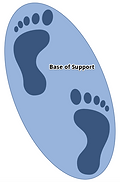Lower-Limb Amputee Rehabilitation
Transfemoral deviations
Stance deviations in transfemoral amputees.
(Murphy, 2013; Spires, Kelly & Davis, 2013)
Foot slap at IC
Foot progresses too quickly from heel contact to flat foot on prosthetic side, creating a slapping sound
Worn out or too soft heel
Excessive socket flexion
Excessive dorsiflexion
Foot rotation at HS
External rotation of prosthetic foot at heel strike
Weak hip musculature and poor control of extensors and medial rotators
Not placing enough weight onto prosthetic foot to compress heel
Prosthetic heel too hard
Plantarflexion bumper too stiff
Poor socket fit --> loss of socket suspension allowing rotation
Excessive toe out
Excessive toe-out of prosthetic limb
Subconscious adaptation to compensate for poor balance and proprioception, in order to maintain centre of gravity within base of support
Prosthetic foot externally rotated
Knee buckling
Excessive knee flexion during stance
Hip flexion contracture --> hip extensor muscles are in a position of mechanical disadvantage
Decreased activation of gluteus max
Knee joint aligned anterior to TKA line
Socket too posterior
Heel height too high
Foot too dorsiflexed
Insufficiently designed socket flexion
Improper setting of knee joint stance control resistance
Drop off in late stance
Downward movement of the body as weight is transferred over the prosthetic foot
Decreased hip abduction strength and control
Soft dorsiflexion bumper
Foot too dorsiflexed
Short foot
Socket set too anterior or foot set too posterior
Example
Decreased push off
Insufficient push off in terminal stance to pre-swing on prosthetic side
Fear of placing entire weight on prosthesis
Dorsiflexion bumper too soft
Foot too far posterior, causing shortened anterior lever arm
Wide base of support
Increased horizontal distance between heels during double support (abducted gait)
Hip abductor contracture or spasticity
Compensation for instability and decreased balance
Proximal-medial socket discomfort
Prosthesis too tall
Inadequately shaped lateral walls insufficiently supporting femur
Narrow base of support
Decreased horizontal distance between heels during double support
Hip adductor contracture or spasticity
Proximal-lateral socket discomfort
Varus/ valgus gait
Knee moves into varus or valgus position during midstance
Abducted (varus) or adducted (valgus) socket
Foot too inset (varus) or outset (valgus)
Deviations
Amputee causes
Prosthesis causes
Lateral lean over weight bearing limb
Trendelenburg gait
Weak hip abductors
Hip abduction contracture
Weak hip extensors
Short residual limb
Poor balance
Poor confidence
Hip pain
Short prosthesis
Socket too abducted
Socket wall providing insufficient femoral support
Socket discomfort

Trendelenburg gait (Corewalking, 2017)


Wide base of support (pdhpe, 2015)
Narrow base of support (pdhpe, 2015)
References:
Corewalking (2017). Trendelenburg gait. Retrieved from: https://corewalking.com/trendelenburg-gait/
Murphy, D. (2013). Fundamentals of Amputation Care and Prosthetics. New York: Demos Medical Publishing.
pdhpe (2015). Base of support. Retrieved from: https://www.pdhpe.net/the-body-in-motion/how-do-biomechanical-principles-influence-movement/balance-and-stability/base-of-support/
Spires, M. C., Kelly, B., & Davis, A. (2013). Prosthetic restoration and rehabilitation of the upper and lower extremity. New York: Demos Medical Publishing
Swing deviations in transfemoral amputees.
(Murphy, 2013; Spires, Kelly & Davis, 2013)
Deviations
Amputee causes
Prosthesis causes
Example
Excessive heel rise
Prosthetic heel rising excessively and rapidly when knee is flexed at the beginning of swing phase
Forceful hip flexion
Prosthesis feeling too heavy
Knee too loose
Insufficient knee friction
Lack of heel rise
Insufficient heel rise during early swing
Swing flexion resistance too stiff, limiting heel rise
Medial whip
Heel of prosthetic foot moves medially at toe off
Stump discomfort
Active forceful hip rotation
Prosthetic knee rotation
Loose socket/ poor suspension
Excessive external rotation of knee mechanism
Incorrectly donning prosthesis
Loose socket that was rotated laterally
Lateral whip
Heel of prosthetic foot moves laterally at toe off
Stump discomfort
Active forceful hip rotation
Prosthetic knee rotation
Loose socket/ poor suspension
Excessive internal rotation of knee mechanism
Incorrectly donning prosthesis
Circumduction
Prosthesis swinging in laterally curved arc during swing phase
Hip abduction contracture
Poor gait habit
Distal medial stump pain
Poor balance
Lack of confidence in knee
Compensatory mechanism to clear prosthetic foot during swing due to long prosthesis
Prosthesis too long
Prosthesis functionally long due to loss of suspension, incorrectly donning prosthesis, or wearing too many socks
Excessive knee friction
Knee locked in extension
Foot in excessive plantarflexion
Swing phase resistance not triggered due to lack of weight bearing onto prosthesis during stance
Vaulting
Plantarflexion during midstance on intact limb to clear prosthetic foot while prosthesis moves through swing
Can often accompany circumduction
Weak hip flexors
Forceful hip flexion to put knee into extension
Desire to keep knee locked during ambulation
Bad habit developed from using a too-long prosthesis
Compensatory mechanism to clear prosthetic foot during swing phase due to long prosthesis
Prosthesis too long
Prosthesis functionally long
Excessive knee friction
Knee locked in extension
Foot too plantarflexed
Inadequate suspension
Uneven step length
Asymmetrical gait pattern with shorter step length on intact side, and long step length on prosthetic side. This coincides with increased stance time on sound limb.
Decreased balance or proprioception on prosthetic limb
Fear of weight acceptance on prosthetic side
Fear of falling
Hip flexion contracture of residual limb
Decreased anterior pelvic rotation on prosthetic side
Pain caused by impingement of anterior brim of socket
Terminal swing impact
Knee reaches extension with too much force prior to heel strike, with a visible or audible impact
Too forceful hip flexion
Decreased proprioception
Patient wants to ensure that the prosthesis will be extended for full weight acceptance
Poor gait habit
Inadequate knee friction
Knee extension aid too strong
Absent or worn extension bumper
Hip hiking
Lateral elevation of pelvis on prosthetic side at end of swing phase with knee in extension
May accompany both vaulting and circumduction
Weak hip flexors
Poor co-ordination
Prosthesis too long
Prosthesis functionally too long
Excessive knee friction
Inadequate suspension